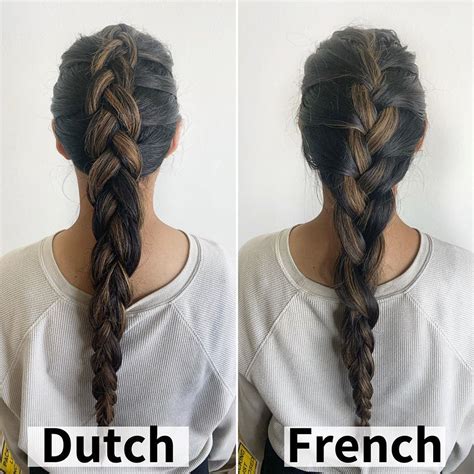Introduction
The world of hair braiding is vast and diverse, with countless styles and techniques to choose from. Among the most popular and versatile braids are the French braid and the Dutch braid. Both braids are characterized by their intricate patterns and elegant appearance, but they differ in several key aspects. This guide will delve into the differences between French and Dutch braids, providing detailed instructions, helpful tips, and comparisons to assist you in creating stunning braids that complement your style.

Table 1: French vs Dutch Braid Comparison
| Feature | French Braid | Dutch Braid |
|---|---|---|
| Origin | France | Netherlands |
| Technique | Underhand | Overhand |
| Appearance | Raised | Inverted |
| Skill Level | Beginner | Intermediate |
French Braid: A Classic Hairdo
History
The French braid originated in France in the 16th century and has since become a timeless classic. It is often associated with elegance and femininity, adding a touch of sophistication to any hairstyle.
Technique
- Section your hair: Part your hair into three even sections.
- Start braiding: Cross the right section over the middle section.
- Add hair: Pick up a small strand of hair from the right side and cross it over the newly formed middle section.
- Continue braiding: Repeat steps 2 and 3 on the left side, alternating between right and left until you reach the end of your hair.
- Secure the braid: Tie the end of the braid with a hair elastic or ribbon.
Dutch Braid: An Intricate Involution
History
The Dutch braid, also known as a reverse French braid, emerged in the Netherlands as a variation of the classic French braid. It gained popularity for its distinctive inverted appearance, creating a textured and voluminous look.
Technique
- Part your hair: Divide your hair into three equal sections.
- Cross under: Cross the right section under the middle section.
- Add hair: Gather a small section of hair from the right side and cross it under the newly formed middle section.
- Repeat: Continue crossing under strands from both sides, alternating between right and left.
- Finish the braid: Secure the end of the braid with a hair elastic or ribbon.
Comparison of Crafting
French and Dutch braids share a superficial resemblance, but their techniques differ significantly. French braids are crafted by crossing hair sections over each other (underhand), while Dutch braids involve crossing sections under (overhand). This fundamental difference results in distinct appearances: French braids exhibit a raised pattern, while Dutch braids show an inverted or “inside-out” effect.
Table 2: Technique Comparison
| Technique | French Braid | Dutch Braid |
|---|---|---|
| Hair Cross | Over | Under |
| Appearance | Raised | Inverted |
Table 3: Suitability for Hair Types
| Hair Type | French Braid | Dutch Braid |
|---|---|---|
| Fine | Yes | Yes (adds volume) |
| Medium | Yes | Yes (enhances fullness) |
| Thick | Yes (controls frizz) | Not recommended (can appear bulky) |
Styling Versatility
Both French and Dutch braids offer endless styling possibilities, catering to different preferences and face shapes. Here are some variations:
- Partial Braids: Start the braid at the crown or side of the head for a partial, glamorous touch.
- Pull-Through Braids: Create a loose, voluminous effect by pulling small sections of hair through the braid.
- Messy Braids: Braid slightly damp hair and tug on the sides to create a relaxed, beachy look.
Tips for Braiding Success
- Practice makes perfect: The more you practice, the easier and faster the braiding process becomes.
- Use a brush: Brushing your hair before braiding removes tangles and ensures a smooth finish.
- Section carefully: Evenly sectioning your hair is crucial for a balanced and symmetrical braid.
- Tighten gradually: Tighten the braid gradually as you work your way down to avoid breakage.
- Secure with style: Experiment with different hair ties or ribbons to add a personal touch.
Frequently Asked Questions
- Which braid is more difficult? Dutch braids can be slightly more challenging for beginners due to the overhand technique.
- Which braid is more suitable for short hair? French braids can be adapted for shorter hair, while Dutch braids may not be practical for lengths above shoulder height.
- Can I sleep in a braid? Yes, sleeping in a braid can help prevent tangles and preserve your hairstyle.
- How often should I wash my hair before braiding? Wash your hair 1-2 days before braiding to maintain cleanliness and prevent product buildup.
- Can I add extensions to my braid? Yes, hair extensions can be added to enhance length and volume.
- What products can I use to enhance my braid? Hairspray, mousse, and shine serum can help hold the braid and add luster.
- How can I incorporate braids into different hairstyles? Braids can be incorporated into buns, ponytails, half-up styles, and even crowns.
- What are some creative braiding techniques? Experiment with fishtail braids, waterfall braids, and Dutch braids with multiple sections.
Conclusion
The French braid and the Dutch braid are timeless hair styling techniques that offer both elegance and versatility. Understanding the differences between these two braids empowers you to select the most suitable style for your hair type, personal preference, and desired look. Whether you opt for the classic French braid or the intricate Dutch braid, the key is to practice and experiment until you master the craft and create stunning braids that turn heads.
